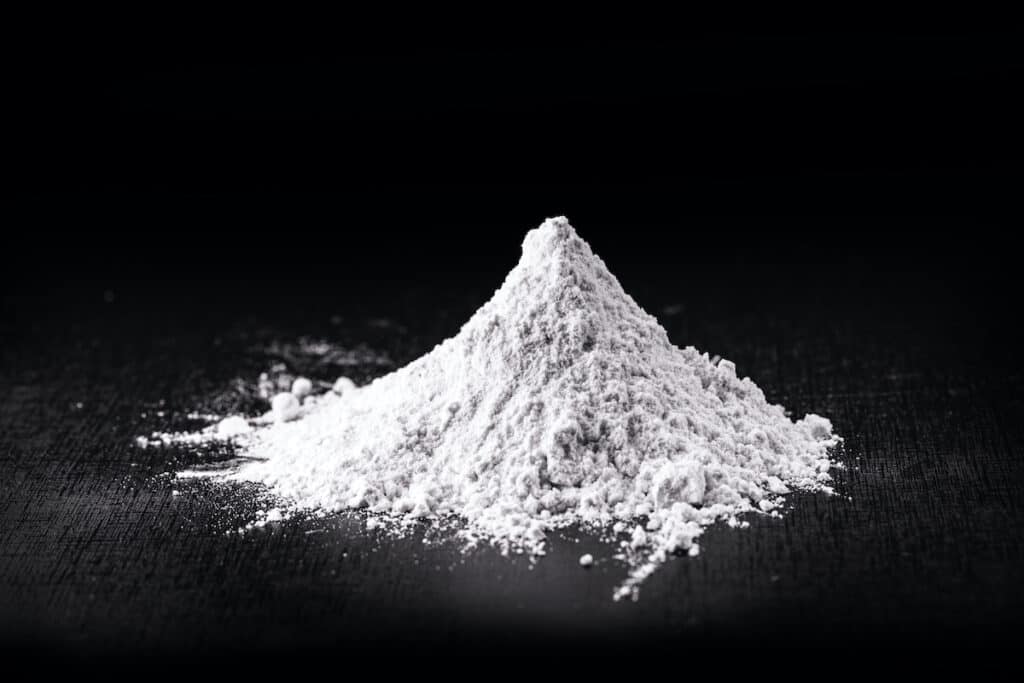Let’s start with titanium (Ti). This periodic table element was discovered in the late 1700s and its name is derived from Titans, pretty much because it’s as strong as steel (not an element, BTW, but an alloy of iron & carbon) but less dense (1). Ti is shiny and silvery and hard and is the ninth most abundant element on earth. It’s used to make metal alloys that are stronger and lighter for aircraft, spacecraft, and the expensive golf club your significant other is hiding from you in the trunk of their car.

The global production of Ti is huge (2). But by far the largest use (90%) is in the manufacture of Titanium dioxide—TiO2—a bright white pigment added to paints (3), plastics, paper, and mineral sunscreens because it absorbs and scatters UV light (4). It’s also found in cosmetics (as brighteners), soap, toothpaste, and in foods and drugs as a colorant, so we do actually ingest titanium (5). Seriously, it has been used in more products than you can even imagine for about 100 years (6, 7).
Ti was/is considered harmless to humans because it has no known biological role (1), nor does it appear to interfere with metal-containing proteins/enzymes in our body like, say, mercury does (Hg)(8).
As a food additive, TiO2 is labeled E-171, and E-171, and thus TiO2, was banned in Europe this year. Why? Well, that’s just it. There’s no research to show it’s harmful—only that the commission included research that couldn’t definitively say it ISN’T harmful (9).
Neither the U.S. nor Canada has banned TiO2 usage in food (10). Both countries consider the TiO2 additives safe because there’s no evidence that they are not. TiO2 as E-171 is actually in a lot of candy and food (16). So, the Skittles lawsuit (initialed by an American who eats WAY too many Skittles) is because of the European ban of E-171 (11).

What’s going on? It turns out all this hubbub is not because of the Ti, but because of one of the two different grades of TiO2. The grade used as a food and drug additive is high-purity pigment grade—particles 200-350nM in size. But a second grade is manufactured for use in, for instance, sunscreens and solar panels because it’s transparent. Nanograde TiO2 is made up of ultrafine particles ~100nM (8) in size, so 2 to 3 times smaller than the food grade TiO2. But this nanoparticle TiO2 is the focus of the hullabaloo.
We need to take a step back and talk about nanoparticles and lungs first. It turns out there are decades of research on nanoparticles (not TiO2, necessarily) and harm they do to lung tissue (12). The lungs can clear a lot of the dust and other stuff we breath in everyday, but it has a harder time getting rid of nano-particulates. Because they hang around in the lung for a long time, they can stimulate the immune system and cause inflammation and increased mucus production which traps bacteria and other stuff we normally cough up and get rid of, which can lead to chronic inflammation then chronic lung disease and maybe emphysema or cancer… You get my drift. For lungs, nanoparticles are BAD.
But are TiO2 nanoparticles bad if they’re ingested? Wait, Potenza!, you say. The E-171 food additive isn’t nanoparticle size. It’s bigger. And it turns out that the bigger size of the high-purity pigment grad TiO2 is handled handily but the gut and, ahem, escorted out. But the argument is that the high-purity pigment grade TiO2 can be contaminated with up to 43% of the nanograde TiO2! (13).
What some scientists are worried about is not only how the gut microvilli cells are handling the TiO2 nanoparticles, but how nanoparticles might change or damage the gut microflora. That’s right. The gut bacteria. With so many people diagnosed with gut issues like irritable bowel disease (IBD) and irritable bowel syndrome (IBS) (14) and with the gut so involved in immune processes… Now you understand why NOT ruling out E-171/TiO2 as dangerous might raise a red flag.

I know there’s a lot of information here and that it is filtered through me, so I recommend clicking on and reading references 12 and 13 for more information, realizing one important thing. Scientists are grifters, so they will say things that get them attention and result in taxpayer money supporting their research. Take out the cowbell and dial the articles down from 11 (15). And take the word of most scientists with a nanoparticle of NaCl (salt).
As always, these are my own opinions based on my biases, knowledge, and understanding, and the websites I’ve linked are in no way an endorsement.
What do I mean, MORE COWBELL? Watch this video.
Then LISTEN to this.



 Arsenic, Poison Books, and The Periodic Table of Death
Arsenic, Poison Books, and The Periodic Table of Death
Leave a Reply